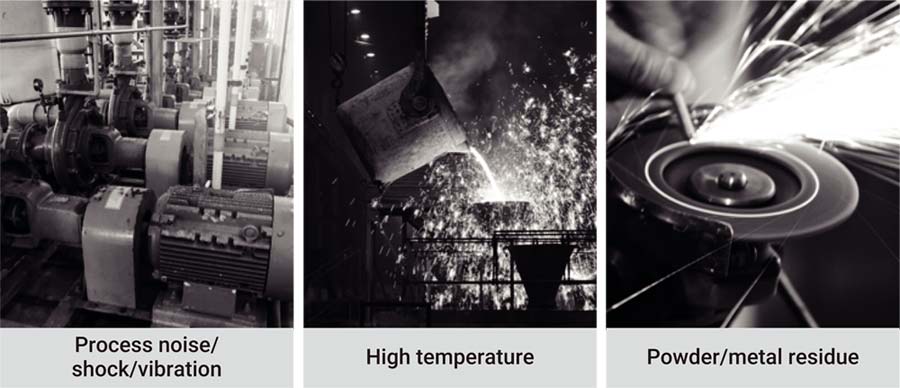Overview
The process of powder metallurgy allows for mass production of specific small components/ parts without near-zero waste of production material. Various metal powders are prepared or mixed into proper proportions or one can use pre-alloyed powder that matches your component functional needs. The initial pressing process produces a “compact” or the form of the desired part, but at this stage, the parts inhibit a green strength, designed for handling purposes only. The compact parts are then sent to a sintering furnace where they are heated just below the melting point so particles are bonded more tightly (denser) than before to form structural strength. The sintering process includes a pre-heat, high-heat (hot zone) and a cool-down zone. To ensure proper sintering, the heating rate, maximum sintering temperature, time at the sintering temperature, cooling rate and furnace atmosphere must all be controlled and monitored closely, or otherwise, defects may occur for the finished product. This is where the powder metallurgy product inspection comes in.

Problem-solving
Slow inspection rate and worker availability
The powder metallurgy production generally produces small single shaped components in high volume that require inspection before they can be delivered to customers. But with production in high volume, the human eye inspection is just not fast enough to meet demands.
Adding fuel to the fire, worker availability has been limited by the current pandemic or factories are forced to downsize to work with limited workers for social distancing reasons.
Human inspection consistency/ accuracy
There are multiple stages where the powder metallurgy process may cause varying degrees of defects on the finished product. With the high production volume, the ability to consistently and accurately pick out the defects by the human is often affected by one’s objectivity on what is considered to be a defect and fatigue after long work hours.
Automated inspection deployment environmental challenges
The thought of implementing automated inspection came to mind but was immediately met with environmental challenges such as shock and vibration from machines, high temperature and metal powder dispersed in the air that may find its way into the computer chassis.

Problem-solved
By implementing a machine inspection (software + Neousys embedded computer) solution, it solves the need for a high volume number of workers to inspect. The machine inspection solution utilizes a Nuvo-8023 box PC with frame grabber expansion cards. The Nuvo-8000 series computers come with patented dampening brackets to withstand shock and vibration which is MIL-STD-810G certified; true fanless design to avoid metal powder dust accumulation inside the chassis; and proven to sustain optimal operation up to 60°C without performance degradation. Connected it to PoE cameras, coupled with appropriate lighting, lighting controller for high-speed image capture and detection software algorithm, it can detect indents, protrusions, discolorations, press marks, scratches, etc. The recognized and distinguished defects are saved into the existing database for the system to learn and reference from for better consistency and accuracy.

The machine inspection solution also offers superior productivity. The volume inspected per day can reach up to 86 thousand samples with an inspection time of 1 second per sample, compared to approximately 4000 sample inspections per worker, per day.

With an ever-increasing database of defect/ non-defect images to learn and reference from, the system continues to reinforce its consistency and accuracy every time it scans a sample. This is one of the reasons why machine learning inspection also consistently post higher accuracy rates while continuing to learn by adding data to the existing database. As for consistency, unlike human inspectors that may experience fatigue, bias or are limited by different vision capabilities from various workers, machine vision cameras coupled with appropriate lighting can inspect unbiasedly and consistently, 24/7.
Considering the better consistency, accuracy and productivity, the benefits of investing in machine learning inspection for powder metallurgy outweigh the cost, in the long run.
Benefits of Neousys Embedded Computers
Neousys rugged embedded platforms offer the following advantages:
Environmental
- True -25°C up to 60°C wide-temperature operations for harsh, volatile environments
- Tri-axis tested patented damping bracket to withstand shock and vibration conditions
Connectivity/ expandability
- PoE+ connectivity for GigE cameras
- USB3.1 Gen1/ Gen2 connectivity for USB cameras
- Connection ports with screw-lock for rugged connectivity
- WiFi 6/ WiFi 5/ 5G/ 4G wireless communication, expansion via mini-PCIe module
Inference processing power
- Support up to dual NVIDIA RTX 30/ 20 series graphics cards
- Support up to NVIDIA® RTX 30/ 20 series graphics cards
- Support up to NVIDIA® Tesla/ Quadro inference accelerators
Electrical
- Patented SuperCAP UPS to counteract unforeseen power interruptions
- Wide-range DC input
Expansion cards
- PCIe PoE expansion card with independent controllers to ensure maximum throughput
- LTN lighting controller is ideal for high-speed image capture with 2A continuous output, 10A overdriving output, accepts strobe signals from cameras or proximity sensors
Some features may be model specific, please refer to the Neousys website for details.






